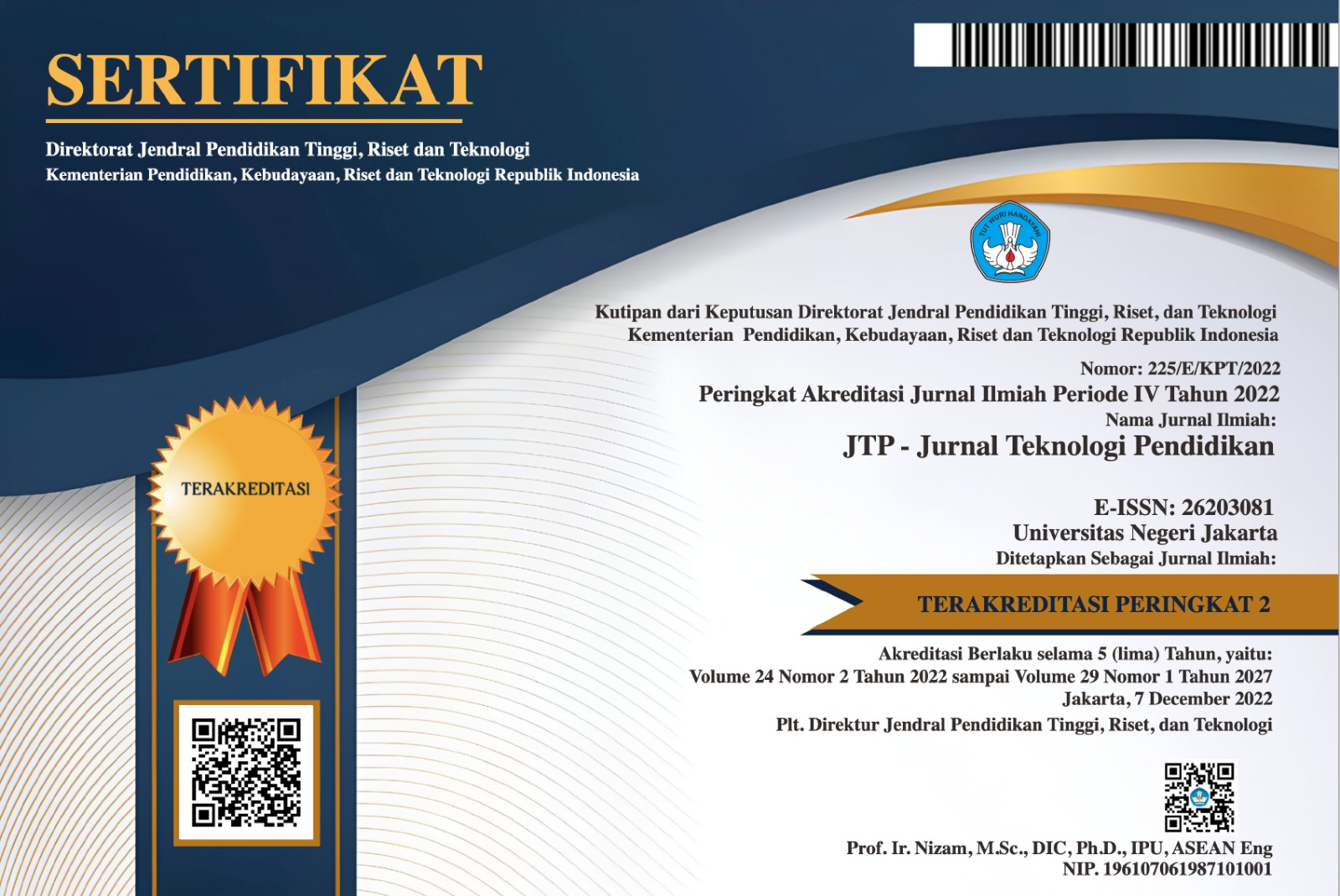Augmented Reality in Improving Writing Skills Learning Experiences in Vocational High School Students
DOI:
https://doi.org/10.21009/jtp.v26i3.49844Keywords:
Instructional Media, Augmented Reality, Learning Experience, Writing SkillsAbstract
This arises from adapting 21st century learning in the form of learning skills, literacy skills, life skills, skills and attitudes, as well as mastery of technology. 21st century learning will improve students' learning experience, especially learning Indonesian with the topic of writing internship reports even though the teacher still provides stimulants in class using learning media. Augmented Reality (AR). The purpose of this research is for media development Augmented Reality (AR) in improving the learning experience of writing skills, knowing the suitability of the media Augmented Reality (AR) in improving the experience of learning writing skills, and knowing the effectiveness of the media Augmented Reality (AR) in improving the experience of learning writing skills Research methods used is research and development or Research and Development (R&D) which adopts the Lee and Owen development model with 5 stages, namely needs analysis, analysis front-end, design, development, implementation, and evaluation (ADDIE). The results of the development are application products with learning media augmented reality.
References
Azuma R. T., “A Survey of Augmented Reality,” In Presence: Teleoperators and Virtual Environments, Vol.6, No.4, 1999, pp.355–385.
Billinghurst, M. “The MagicBook: A Transitional AR Interface”, Ivan Poupyrev, 2001.
Fricticarani, A., Hayati, A., R, R., Hoirunisa, I., & Rosdalina, G. M. (2023). Strategi pendidikan Untuk Sukses Di Era Teknologi 5.0. Jurnal Inovasi Pendidikan Dan Teknologi Informasi (JIPTI), 4(1), 56–68. https://doi.org/10.52060/pti.v4i1.1173.
Hawtry, K. (2007). Using experiential techniques. Journal of Economic Education, Spring, 143-152.
Kolb, D.A. (1984) Experiential Learning: Experience as the Source of Learning and Development. Prentice-Hall, Inc. Englewood Cliffs, NJ.
Kolb, D.A., Boyatizis, R.E., & Mainemelis, C. (1999) Experiential Learning Theory: Previous Research and New Directions. Retrieved June 10, 2009 http://www.learningfromexperience.com/html/research_library.html.
Kolb, A. & Kolb, D. A. (2005) The Kolb Learning Style Inventory – version 3.1 2005 Technical Specifications. Retrieved June 10, 2009 http://www.learningfromexperience.com.
Luan, N. M., Rajendran, M., Subramanian, J., Jaisankar, D., Oli, L., & Prakash, A. (2024). Exploration of Factors Causing Difficulties in Students’ Writing Skills. World Journal of English Language, 14(4), 447–458. https://doi.org/10.5430/wjel.v14n4p447.
Malaka, R., Schneider, K., and Kretschmer, U. Stage-Based Augmented Edutainment. In LCNS 3031 (2004), 54–65 https://www.icg.tugraz.at/∼daniel/HistoryOfMobileAR/, History of Mobile Augmented Reality, 2009.
Miyashita T., et al., “An augmented reality museum guide,” 7th IEEE International Symposium on Mixed and Augmented Reality 2008, 2008, pp.103–106.
Mustaqim, I., & Kurniawan, N. (2017). Pengembangan Media Pembelajaran Movie Learning Berbasis Augmented Reality. Jurnal Edukasi Elektro, 1(1), 36–48.
P. Milgram and A.F. Kishino, “Taxonomy of Mixed Reality Visual Displays” (http://vered.rose.utoronto.ca/people/pauldir/IEICE94/ieice.html)IEICE Transactions on Information Systems, E77-D(12), pp. 1321–1329, 1994.
Reitmayr, G. & Schmalstieg, D. (2003). “Location based Applications for Mobile Augmented Reality”, AUIC2003.
Shonima, P., & Sowmya, K. S. (2024). Augmented Reality: Transforming Learning Landscapes in Education. International Journal of Research Publication and Reviews, 5(1), 1555–1564. https://doi.org/10.55248/gengpi.5.0124.0213.
Smart, K.L. & Csapo, N. (2007) Learning by doing: Engaging students through learner- centered activities. Business Communication Quarterly, 70(4), 451-457.
Sudrajat, Y., & Sari, N. W. A. P. (2022). How to make instrument writing skill rubric? Hortatori: Jurnal Pendidikan Bahasa Dan Sastra Indonesia, 6(2), 120–128. https://doi.org/10.30998/jh.v6i2.1319
Ursula Kretschmer, Volker Coors, Ulrike Spierling, Dieter Grasbon, Kerstin Schneider, Isabel Rojas, Rainer Malaka, Meeting the spirit of history, Proceedings of the 2001 conference on Virtual reality, archeology, and cultural heritage, November 28–30, 2001, Glyfada, Greece https://doi.org/10.1145/584993.585016
Downloads
Published
How to Cite
Issue
Section
License
Copyright (c) 2024 Ni Wayan Ayu Permata Sari, Yayan Sudrajat, Suwito Casande, Muhammad Syarif, Angie Melody Monarchi

This work is licensed under a Creative Commons Attribution-ShareAlike 4.0 International License.
Jurnal Teknologi Pendidikan is an Open Access Journal. The authors who publish the manuscript in Jurnal Teknologi Pendidikan agree to the following terms.
Attribution-ShareAlike 4.0 International (CC BY-SA 4.0)
-
Attribution — You must give appropriate credit, provide a link to the license, and indicate if changes were made. You may do so in any reasonable manner, but not in any way that suggests the licensor endorses you or your use.
-
ShareAlike — If you remix, transform, or build upon the material, you must distribute your contributions under the same license as the original.
- No additional restrictions — You may not apply legal terms or technological measures that legally restrict others from doing anything the license permits.
Notices:
- You do not have to comply with the license for elements of the material in the public domain or where your use is permitted by an applicable exception or limitation.
- No warranties are given. The license may not give you all of the permissions necessary for your intended use. For example, other rights such as publicity, privacy, or moral rights may limit how you use the material.







